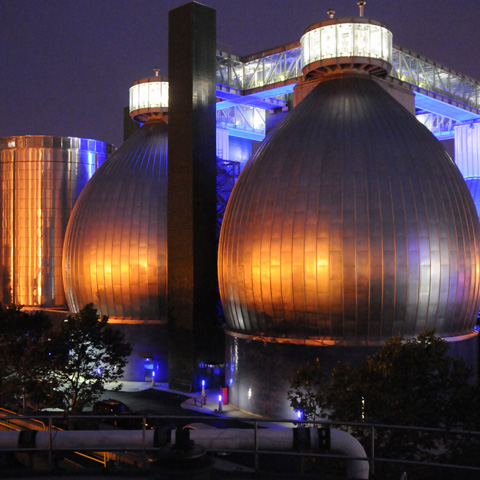
 Environmental Protection311
Environmental Protection311 Search all NYC.gov websites
Search all NYC.gov websites
Wastewater Treatment System
New York City’s 14 Wastewater Resource Recovery Facilities together treat 1.3 billion gallons of wastewater daily. Each person can help our wastewater treatment system run better by conserving water, disposing of garbage and household chemicals properly and being concerned about water quality in the New York City’s waterways. To learn more about how you can help protect our sewer system and local waterways, visit Safe Disposal of Harmful Products. To learn more about the types of sewer systems that serve New York City, visit Sewer System.
Wastewater Resource Recovery Facilities
The amazing treatment system that cleans our wastewater consists of: over 6,000 miles of sewer pipes; 135,000 sewer catch basins; over 495 permitted outfalls for the discharge of Combined Sewer Overflows; 95 wastewater pumping stations that transport it to 14 wastewater resource recovery facilities located throughout the 5 boroughs.
Learn more about our 14 Wastewater Resource Recovery Facilities
Wastewater Treatment Process
When you take a shower or brush your teeth, do you ever wonder where where the used water (we call it “wastewater”) goes? Each day, we treat 1.3 billion gallons of wastewater at New York City’s 14 wastewater resource recovery facilities.
Resource Recovery
Sludge and Biogas
Sludge is the solid byproduct of wastewater treatment. Once further processed, its use is regulated by both the federal and state governments. New York City’s sludge is digested, which is a form of processing that microbiologically transforms material and creates “biogas,” a type of renewable energy. Learn more about Resource Recovery.
Biosolids
After digestion, the leftover solids are then dewatered. Dewatering is a process where the solid components of sludge are separated from the liquid components mechanically (we use centrifuges). Not all of the city’s 14 wastewater resource recovery facilities have onsite dewatering facilities. Those facilities without dewatering capabilities transport their solids through force mains or marine vessels to in-city facilities that have onsite dewatering capabilities. After dewatering, the leftover solid product of the processed sludge is generally referred to as “biosolids.” The city’s biosolids are managed by outside contractors who take it to landfills for disposal or further process it to recover its value as a nutrient-rich soil amendment.
As part of our commitments in OneNYC, we have a goal of zero-landfilling of biosolids by 2030. This means we will develop a program to reuse all biosolids beneficially. Some of the further processing technologies that can be used to qualify biosolids for reuse include composting, drying, and gasification or pyrolysis. New York City produces about 1,400 tons/day of biosolids or about 60 truckloads! Such a large quantity spread out over our 6 dewatering facilities means that our beneficial use program will need to be diverse and include multiple types of further treatment. DEP has developed a plan to get our biosolids to 100% beneficial use by 2030; for more information, download the Biosolids Beneficial Use Plan Brochure.
To learn more about biosolids, we recommend visiting:
Significant Non-Compliance List
DEP is required to publish a list of establishments in New York City that were in significant non-compliance with pretreatment standards and other wastewater requirements.
Reimagining Rikers Island
Feasibility Study for a new wastewater resource recovery facility on Rikers Island.
Resource Recovery
DEP is advancing NYC’s circular economy by recovering energy and nutrients from organic waste.
Safe Disposal of Harmful Products
Learn how to properly dispose of products that can clog our sewer system or harm our environment.
Resources for Educators
Use our maps, virtual tours, education modules and more to learn about New York City’s Environment.







